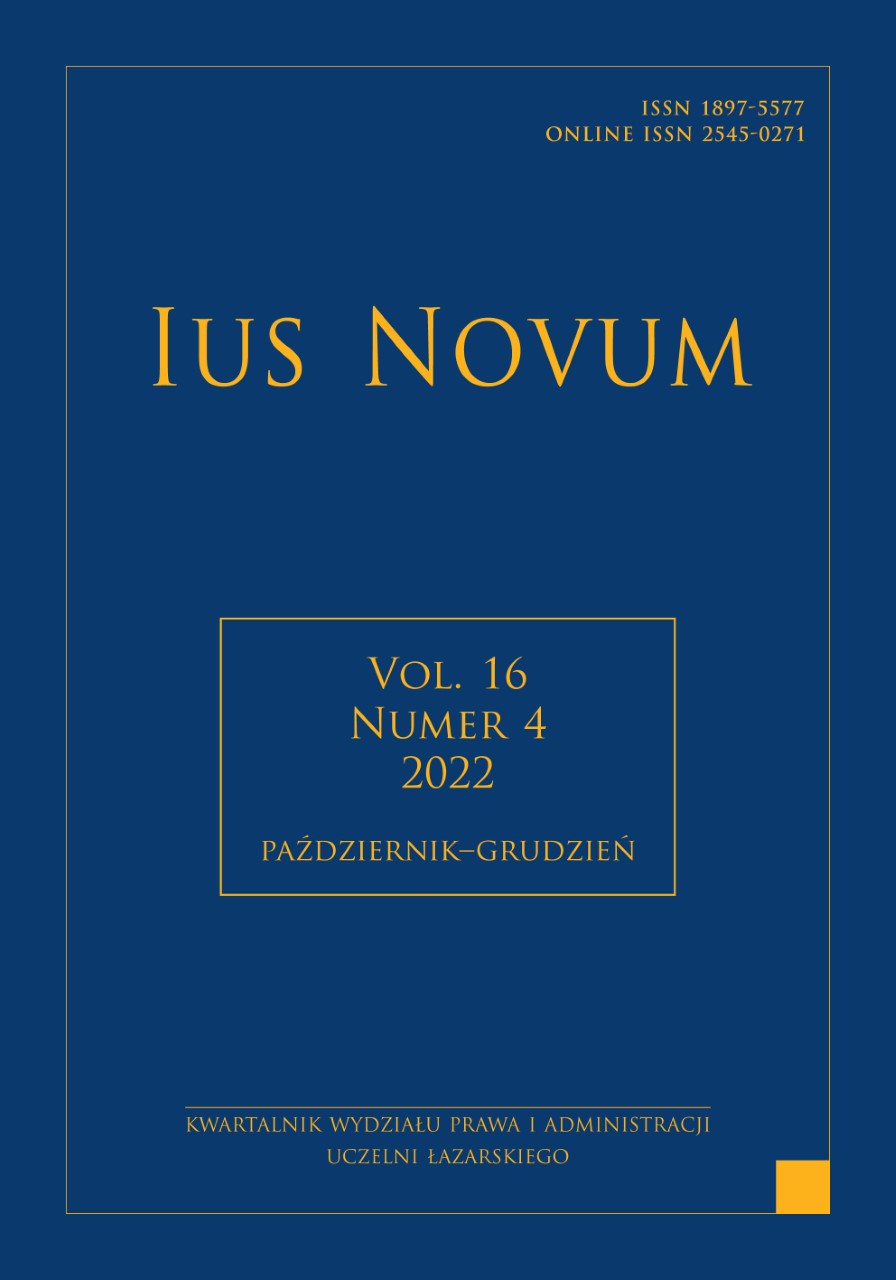Abstract
The use of legal highs increases risks in the area of public health in Poland. The law provides
for criminal liability for possession as well as the trade of NSP, however, it does not provide
for the compulsion of treatment for addicts. The material used as a starting point for a practical
presentation of the discussed issues was statistical data on the intake of “legal highs” in Poland
in the years 2015–2017, including the number of deaths caused by their use. The authors also
conducted a study in the form of analysis of data contained in individual medical records of
patients hospitalized in the Acute Poisoning Department of J. Nofer Institute of Occupational
Medicine in Lodz due to the consumption of new psychoactive substances. The paper uses the
method of analysis of the existing legal regulations, referring at the same time to the doctrine
of law and the emerging line of jurisprudence. The analysis of the legitimacy of the introduction
of compulsory treatment mechanisms for people returning to the use of designer drugs
shows the tendency of their cyclical use by patients of the acute poisoning department IMP
in Lodz. In connection with the number of legal highs poisonings in Poland, it is necessary to
introduce legal algorithms of conduct concerning the obligation to treat persons using designer
drugs harmfully and persons addicted to them. Legal highs, compulsory treatment, new
psychoactive substances, legal highs poisoning, protection of public health.
References
Adamowicz P., Meissner E., Maślanka M., Fatal Intoxication with New Synthetic Cannabinoids AMB-FUBINACA and EMB-FUBINACA, „Clinical Toxicology” 2019, nr 57 (11).
Adamowicz P., Jurczyk A., Gil D., Szustowski S., A Case of Intoxication with a New Cathinone Derivative α-PiHP – A Presentation of Concentrations in Biological Specimens, „Legal Medicine” 2020.
Barcelo B., Gomila I., Pharmacology and literature review based on related death and non-fatal case reports of the benzofurans and benzodifurans designer drugs, „Current pharmaceutical design” 2017, vol. 23, nr 36.
Betzler F., Ernst F., Helbig J., Viohl L., Roediger L., Meister S., Romanczuk-Seiferth N., Heinz A ., Ströhle A., Köhler S., Substance Use and Prevention Programs in Berlin’s Party Scene: Results of the SuPrA-Study, „European Addiction Research” 2019, vol. 25, nr 6.
Biliński P., Hołownia P., Kapka-Skrzypczak L., Wojtyła A., Designer Drug (DD) Abuse in Poland; A Review of the Psychoactive and Toxic Properties of Substances Found From Seizures of Illegal Drug Products and the Legal Consequences Thereof. Part 1 – Cannabinoids and Cathinones, „Annals of Agricultural and Environmental Medicine” 2012, vol. 19 nr 4.
Bježančević M., Dodig-Ćurković K., Palić Kramarić R., ‘Air Fresheners’ As Legal Highs, „Croatian Medical Journal” 2019, vol. 60, nr 4.
Dawson J.B., The Australasian Approach to the Definition of Mental Disorder in a Mental Health Act, „Medical Law Review” 2018, vol. 26, nr 4, https://doi.org/10.1093/medlaw/fwx057.
Drabek M., Andysz A., Wpływ zażywania marihuany i amfetaminy (oraz jej pochodnych) na prowadzenie pojazdów na podstawie wyników badań symulatorowych, „Medycyna Praktyczna” 2011, vol. 62, nr 5.
European Monitoring Centre for Drugs and Drug Addiction – EMCDDA. European drug report 2018: Trends and developments. Luxembourg: Publications Office of the European Union, http://www.emcdda.europa.eu/system/files/publications/8585/20181816_TDAT18001PLN_PDF.pdf (dostęp: 20.02.2022).
Evans-Brown M., Sedefov R., Responding to New Psychoactive Substances in the European Union: Early Warning, Risk Assessment, and Control Measures, „Handbook of experimental pharmacology” 2018, nr 252, https://doi.org/10.1007/164_2018_160.
Report of the Commission on progress in the EU’s 2013–2020 Drugs Strategy and 2013–2016 EU Action Plan on Drugs. Brussels, 27.11.2015 COM(2015) 584 final.
Fattore L., Weinstein A.M., Editorial: Novel Psychoactive Drugs, „Frontiers in psychiatry” 2019, nr 10, s. 119, https://doi.org/10.3389/fpsyt.2019.00119.
Global Commission on Drug Policy – GCDP. The War on Drugs, 2011, http://www.globalcommissionondrugs.org/wp-content/uploads/2017/10/GCDP_WaronDrugs_EN.pdf (dostęp: 13.02.2022).
Global Commission on Drug Policy – GCDP. Advancing Drug Policy Reform: A New Approach To Decriminalization, Global Commission on Drug Policy, 2016, http://www.globalcommissionondrugs.org/wp-content/uploads/2016/11/GCDP-Report-2016-ENGLISH.pdf (dostęp: 20.02.2022).
Global Commission on Drug Policy – GCDP. Regulation The Responsible Control of Drugs, 2018, https://www.globalcommissionondrugs.org/wp-content/uploads/2018/09/ENG-2018_Regulation_Report_WEB-FINAL.pdf (dostęp: 20.02.2022).
Raport Głównego Inspektora Sanitarnego. Nowe narkotyki w Polsce 2017–2018, https://gis.gov.pl/wp-content/uploads/2017/08/Raport-G%C5%82%C3%B3wnego-Inspektora-Sanitarnego. Nowe-narkotyki-w-Polsce-2017-2018.pdf (dostęp: 30.03.2022).
Huestis M.A., Tyndale R., Designer Drugs 2.0, „Clinical Pharmacology & Therapeutics” 2017, vol. 101, nr 2, https://doi.org/10.1002/cpt.575.
Kadkhodaei K., Kadisch M., Schmid M., Successful Use of a Novel lux® i-Amylose-1 chiral column for Enantioseparation of “legal highs” by HPLC, „Chirality” 2020, vol. 32, nr 1, s. 42–52, https://doi.org/10.1002/chir.23135.
Karkowska D., Prawo ochrony zdrowia w pytaniach i odpowiedziach – prawa pacjenta, Warszawa 2008.
Kłak C., The New Definition of ‘Surrogate Substance’ within Countering Drug Addiction Act of 29th July 2005 – is it needed?, „Przegląd Więziennictwa Polskiego” 2017.
Luciano R., Perazella M., Nephrotoxic Effects of Designer Drugs: Synthetic Is Not Better!, „Nature Reviews Nephrology” 2014, vol. 10, nr 6, https://doi.org/10.1038/nrneph.2014.44.
Malczewski A., Kidawa M., Nowe substancje psychoaktywne w Europie. Skala zjawiska i przeciwdziałanie, „Mazowieckie Centrum Polityki Społecznej” 2018.
Raport Najwyższej Izby Kontroli: Przeciwdziałanie sprzedaży dopalaczy, 2017, https://www.nik.gov.pl/plik/id,17464,vp,20036.pdf.
Pourmand A., Mazer-Amirshahi M., Chistov S, Li A. Park M., Designer Drugs: Review and Implications for Emergency Management, „Human & Experimental Toxicology” 2018, vol. 37, nr 1.
United Nations Office on Drug and Crime – UNODC, „World Drug Report” 2018, vol. 3.
Sewell R., Poling J., Sofuoglu M., The Effect of Cannabis Compared with Alcohol on Driving, „The American Journal on Addictions” 2009, vol. 18, nr 3.
Walvisch J., Defining Mental Disorder in Legal Contexts, „International Journal of Law and Psychiatry” 2017, nr 52, s. 7–18, https://doi.org/10.1016/j.ijlp.2017.04.003.
Wang G.S., Hoyte C., Novel Drugs of Abuse, „Pediatrics in Review” 2019, vol. 40, nr 2, s. 71–78, https://doi.org/10.1542/pir.2018-0050.
Wroński K., Frąckowiak K., Frąckowiak L., Użycie środków przymusu bezpośredniego w stosunku do pacjenta, „Borgis – Medycyna Rodzinna” 2014, nr 4.
Zawilska J.B., Charakterystyka toksykologiczna nowych substancji psychoaktywnych, w: A. Krakowiak, A. Rutkiewicz (red.), Dopalacze od teorii do praktyki klinicznej, Bielsko-Biała 2019.
Zajdel-Całkowska J., Winnicka R., Krakowiak A., Jabłońska M.R., Zajdel R., The Right of a Doctor to Inform an Employer of Contraindications to Perform a Certain Type of Work by an Employee, „Medycyna Pracy” 2018, vol. 69, nr 6, doi: 10.13075/mp.5893.00632.

